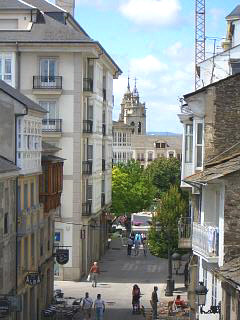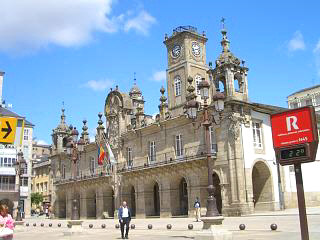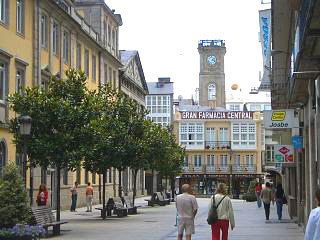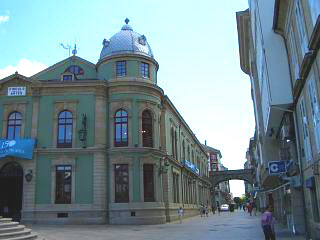The City of Lugo and its old town
The city of Lugo lays claim to be Galicia's oldest and most historic provincial capitol. Its documented history dates back to 14 BC and it was originally called "Lucus Augusti" and foundered by "Paulus Fabius". Lugo is located next to the "Mino" river and shares its name with its encompassing territory. It is approximately one and a half hours drive from Santiago de Compostela.
As you approach Lugo for the first time, your attention will be captured by the city's
 ancient Roman walls that encapsulate the old town. Once spotted, these walls dominate your field of view and prompt an immediate interest in what might lay behind them. Lugo's still intact Roman wall, for which the city is internationally famous, was built in the late third century (about 260 AD) and remains structurally complete today. This results in Lugo having an old town enclosed within the walls and a newer town lying just outside them. You can, if you wish, walk a-top the full length of the wall, or leave it at any of its numerous stairs which will take you down into, or out of, Lugo's older district. The view to the left looks down into Lugo's old town from the top of the Roman wall near the Santiago gate.
ancient Roman walls that encapsulate the old town. Once spotted, these walls dominate your field of view and prompt an immediate interest in what might lay behind them. Lugo's still intact Roman wall, for which the city is internationally famous, was built in the late third century (about 260 AD) and remains structurally complete today. This results in Lugo having an old town enclosed within the walls and a newer town lying just outside them. You can, if you wish, walk a-top the full length of the wall, or leave it at any of its numerous stairs which will take you down into, or out of, Lugo's older district. The view to the left looks down into Lugo's old town from the top of the Roman wall near the Santiago gate.
Lugo is a genuine walled city and has no less than ten different gates offering the only means of access into the original town within. Today visitors are welcome, but this was not always the case and the walls have been the scene of many battles and attempted attacks. Nowadays, things are much calmer and most of the old town is pedestrianised making it easy to explore. Visitors with a car will need to park up outside its perimeter where cheap and ample parking is available.
Once inside the walls, the old town has numerous streets populated by open squares and small gardens. The largest square, surrounded by several grand buildings, is to the west of the old
 town and slopes gradually downwards in the direction of the city's old Cathedral.
town and slopes gradually downwards in the direction of the city's old Cathedral.
Known as the "prazo Maior", this square houses the Town Hall (photo right), a large baroque structure with an impressive fronting constructed in the mid eighteenth century. The "Maior " plaza is also faced by a tall clock tower (connected to the Town Hall) which has been rebuilt, but originates from the sixteenth century. This square is an ideal people watching spot and is the perfect location from which to enjoy a relaxing coffee in one of the many surrounding café bars.
The other significant squares within the city's walls are the plaza of "Santo Domingo" in the town's center, and the plaza of "Santa Maria" behind the cathedral, but there are others and all offer a similar old world charm.
Lugo does have an air of spaciousness about it, even though it is quite compact. The street
 have much more of an open atmosphere to them than either Pontevedra or Santiago de Compostela and the small scale of most of the buildings removes the corridoring effect that you feel in many other Galician towns. A centrally local tourist office (with English speaking staff) can be found in a small arcade just off the main Maior square, previously described, but like everything else it will close for lunch. Above, one of Lugo's streets leading to the Maior square with the clock tower in view.
have much more of an open atmosphere to them than either Pontevedra or Santiago de Compostela and the small scale of most of the buildings removes the corridoring effect that you feel in many other Galician towns. A centrally local tourist office (with English speaking staff) can be found in a small arcade just off the main Maior square, previously described, but like everything else it will close for lunch. Above, one of Lugo's streets leading to the Maior square with the clock tower in view.
As is so often the case, the start of our visit to Lugo fell into the lunch and early afternoon time slot that the Spanish take as their ritual siesta. For this reason many of the shops were closed and the streets were relatively quiet. If you want to visit the cathedral or museum you also need to take account of the siesta as both do close for this period.
As the afternoon progressed, the activity level in the town started to increase again and from about 4.00pm to the time we left the city was back in full swing.

In the background of the image to the right there is what appears to be an arch, but is actually one of the gates leading throught the city's ancient Roman walls.
Of the various gates providing ingress into the city, the "Carmen" gate is perhaps the most famous. It is the entrance most frequently used by passing pilgrims on the "way of St. James" (the pilgrim's route to Santiago) and has the greatest symbolism.
The main cathedral at Lugo was historically a popular destination for catholic visitors and they would seek entry via one of the walls other portals, this time the "Santiago" or "San Pedro" gates (these are more recent points of entry and did not exist in Romans times).
To a visitor most of the sightseeing attractions lie within the walled town, although some large civic buildings, the famous river side spa and the gardens of Rosalia de Castro can be found just outside the walls perimeter.
Lugo's spa
Like Ourense, Lugo's benefits from natural thermal springs and the early Roman settlers made good use of this pre-heated water by creating a city spa complex. Part of this spa still remains (with modern additions) and it is called the "Barrio del Puente" and is open to visitors.
- Bathing in warm waters compensated the Romans for the colder climates they had to tolerate when they invaded territories in the north such as Galicia, parts of France and Anglo Saxon Britain.
Close to the spa is an old Roman bridge.
Return to Lugo Galicia index page.

